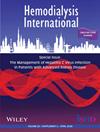Comparison of supraclavicular brachiocephalic and femoral vein approaches for tunneled dialysis catheter placement in patients with thrombosed internal jugular veins
Abstract
Introduction
There is still debate on the best access route in case of bilateral internal jugular vein thrombosis. We aimed to compare the safety, effectiveness, and outcomes of tunneled dialysis catheter placement via supraclavicular brachiocephalic and femoral vein approaches in patients with bilateral internal jugular vein thrombosis.
Methods
Between January 2018 and December 2021, data of the patients in whom tunneled dialysis catheters were placed via the supraclavicular brachiocephalic vein (n = 42) and femoral vein (n = 57) approaches were extracted. Patient demographics, technical and clinical success rates, complications, and outcomes were noted. The Likert scale was used to assess patient satisfaction.
Findings
Forty two (42.4%) patients were men, and the mean age was 61.9 (range, 12–93) years. The technical and clinical success rate was 100% for both groups. No major complication was encountered. The mean follow-up period was 497.5 (range, 32–1698) catheter days. Thirty-day patency was similar for the brachiocephalic vein and femoral vein group (40 [95.2%] vs. 55 [96.5%], p = 0.754). Also, primary and cumulative patency rates were comparable (p = 0.158; p = 0.660). The infection rate was 2.6 and 4.1 per 1000 catheter days for the brachiocephalic vein and femoral vein group. The infection-free survival was significantly higher in the brachiocephalic vein group (71.9% vs. 35.3% at 12 months, p < 0.001). Patient satisfaction was higher in the brachiocephalic vein group (median satisfaction, 5 vs. 4, p < 0.001).
Discussion
Both supraclavicular brachiocephalic vein and femoral vein approaches have high technical and clinical success with comparable patency rates. However, low infection rate and high patient satisfaction make the supraclavicular brachiocephalic vein approach a reasonable alternative before proceeding to the femoral vein access.

 求助内容:
求助内容: 应助结果提醒方式:
应助结果提醒方式:


